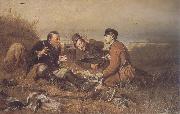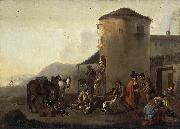Wholesale Oil Painting Reproductions No Minimum and Door to Door! |
|||||||||||
|
|
|||||||||||

|
|||||||||||
|
|
|
||||||||
All Perov, Vasily Oil Paintings |
||||||||
|
|
||||||||
|
|
||||||||
|
Artist Introduction: Russian Painter, 1834-1882
Russian painter. Son of a public prosecutor, he studied intermittently at Arzamas from 1846 to 1849 at the Art School of Alexander Stupin (1776-1862), a classicist painter whose School was the first of its type in provincial Russia, and during the 1850s at the Moscow School of Painting, Sculpture and Architecture under Sergey Zaryanko. The work of Pavel Fedotov, pictorial satire in the press and genre scenes by the Old Dutch masters and William Hogarth were the greatest formative influences on Perov. His early works, permeated by a Biedermeier romantic spirit, combine detailed brushwork with anecdotal narrative and aim at criticizing social behaviour in line with the contemporary democratic doctrines of such writers as Nikolay Chernyshevsky. Such anti-clerical pictures as the Village Sermon (1861; Moscow, Tret'yakov Gal.) are distinguished by a particular irony. As in the prose of Nikolai Leskov, which has many affinities with Perov's painting, there is a conflict between feelings of love and hatred, and between an intimate knowledge of the daily life of the people and an alienating irony. In 1862-4 Perov travelled abroad, working mainly in Paris, where he painted a series of vivid genre scenes of city life. Perov's success as a genre painter reached its peak in the latter half of the 1860s. His compositions become more laconic and expressive; overcoming an indisciplined use of colour, he achieved an impressive unity with an austere greyish-brown palette. Such works as the Drowned Girl (1867) and the Last Tavern by the City Gates |
||||||||
|
|
||||||||
|
Hunters at Rest Painting ID:: 35148 |
mk100
1871
Oil on canvas
119x183cm
|
|||||||
Height Width |
INS/CM Quality |
|||||||
|
X |
| |||||||
|
|
||||||||
All Jan miel Oil Paintings |
||||||||
|
|
||||||||
|
|
||||||||
|
Artist Introduction: Dutch Baroque Era Painter, ca.1599-1664
Flemish painter, active in Italy. Miel must have arrived in Rome in the early 1630s; he immediately came under the influence of Pieter van Laer (il Bamboccio) and the BAMBOCCIANTI. His earliest paintings of bambocciate (low-life scenes) are the Bowls Players (1633; Paris, Louvre) and its companion piece The Cobbler (Besan?on, Mus. B.-A. & Arch?ol.). Shortly after his arrival in Rome, Miel joined the Schildersbent, a confraternity of Netherlandish artists, and was given the nickname 'Bieco' ('threatening look'). His presence in Rome is documented from 1636 to 1658, when he moved to Turin and entered the service of Charles-Emanuel II, Duke of Savoy. Other early paintings that can be attributed to the 1630s include Halt at the Inn (Marseille, Mus. B.-A.) and Hunters' Rest (Warsaw, N. Mus.). Both are reworkings, in their subject-matter and composition, of contemporary paintings by van Laer, such as his Hunters Resting (Florence, Uffizi) and Halt at the Inn (Paris, Louvre). |
||||||||
|
|
||||||||
|
|
Hunters at Rest Painting ID:: 70606 |
Medium Oil on canvas
Dimensions Expression error: Missing operand for *51 ?? 74 cm
|
||||||
Height Width |
INS/CM Quality |
|||||||
|
X |
| |||||||
|
|
||||||||
|
Prev Next
|
||||||||
|
|
||||||||
|
Related Paintings to Jan miel :. |
||||||||
|
|
||||||||
|
CONTACT US |


